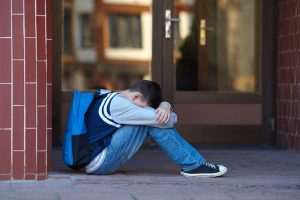Manage big feelings better: Reduce triggers by noticing bodily signals
 For kids with ADHD, managing intense emotions can be extra tough. In the heat of the moment, it’s hard for any of us to hold it together and act the way we’d like to. Breathing techniques, calming phrases or taking a walk are great options that tend to go out the window when you’re angry, frustrated or afraid. Instead, we yell, cry or say inappropriate things. When confronted by a tidal wave of big feelings, kids with ADHD especially struggle to access the parts of themselves that know how to make effective, positive choices. Their weaker executive functioning skills aren’t yet developed enough to exert emotional and verbal control and they often can’t recall how they should be responding. Instead of trying to stop these strong emotions or argue with your son or daughter about their irrational reaction, we have to help kids notice and respond to what’s happening inside of them.
For kids with ADHD, managing intense emotions can be extra tough. In the heat of the moment, it’s hard for any of us to hold it together and act the way we’d like to. Breathing techniques, calming phrases or taking a walk are great options that tend to go out the window when you’re angry, frustrated or afraid. Instead, we yell, cry or say inappropriate things. When confronted by a tidal wave of big feelings, kids with ADHD especially struggle to access the parts of themselves that know how to make effective, positive choices. Their weaker executive functioning skills aren’t yet developed enough to exert emotional and verbal control and they often can’t recall how they should be responding. Instead of trying to stop these strong emotions or argue with your son or daughter about their irrational reaction, we have to help kids notice and respond to what’s happening inside of them.  Practicing and teaching self-regulation requires acting like the GPS in your car: you neutrally observe that you’re off course, stop going in that direction and choose a new route. You notice the physiological signs that you are activated (increased heart rate, perspiration, louder voice), you pause (take a deep breath, change your location and consider what’s most important right now) and you re-direct (make a choice that’s different than a typical reaction). Since most children and teens with ADHD are still cultivating self-awareness, they’ll need your help to detect the signs that a tidal wave is building inside of them. By identifying the pattern of what triggers them and the bodily signs that something is off, you work as a team to reduce their reactivity and decrease their triggers. They’ll feel start to feel a greater sense of self-control and you’ll feel less frustrated with their outbursts.
Practicing and teaching self-regulation requires acting like the GPS in your car: you neutrally observe that you’re off course, stop going in that direction and choose a new route. You notice the physiological signs that you are activated (increased heart rate, perspiration, louder voice), you pause (take a deep breath, change your location and consider what’s most important right now) and you re-direct (make a choice that’s different than a typical reaction). Since most children and teens with ADHD are still cultivating self-awareness, they’ll need your help to detect the signs that a tidal wave is building inside of them. By identifying the pattern of what triggers them and the bodily signs that something is off, you work as a team to reduce their reactivity and decrease their triggers. They’ll feel start to feel a greater sense of self-control and you’ll feel less frustrated with their outbursts.  Follow these steps:
Follow these steps:
- In a calm moment, talk with your son or daughter about things that set them off. What are the bodily responses that signal something is escalating? Usually people have a physical reaction when something bothers them, but they can’t catch their reaction fast enough to make a calmer choice. Share a few ways that you can tell when you are agitated.
- What would they like to do differently and how could you assist them? How could you cue them to respond differently without being provocative? Offer a few of your observations of their behavior and some ideas for alternative choices. Make a list of these and post it in a space that you can all refer to for support in a tough moment.
- Acknowledge all attempts to follow a suggestion on the list as well as successes. Efforting in this area matters a great deal even if it’s not consistent because practice makes progress. Tell them specific ways that you notice this progress and how you appreciate it.
 When you work together to identify triggers and manage the big feelings that accompany them, you’re helping your child or teen build those critical executive functioning skills of self-regulation and self-awareness. It may seem like one slow step at a time but you’re still moving forward!
When you work together to identify triggers and manage the big feelings that accompany them, you’re helping your child or teen build those critical executive functioning skills of self-regulation and self-awareness. It may seem like one slow step at a time but you’re still moving forward!
